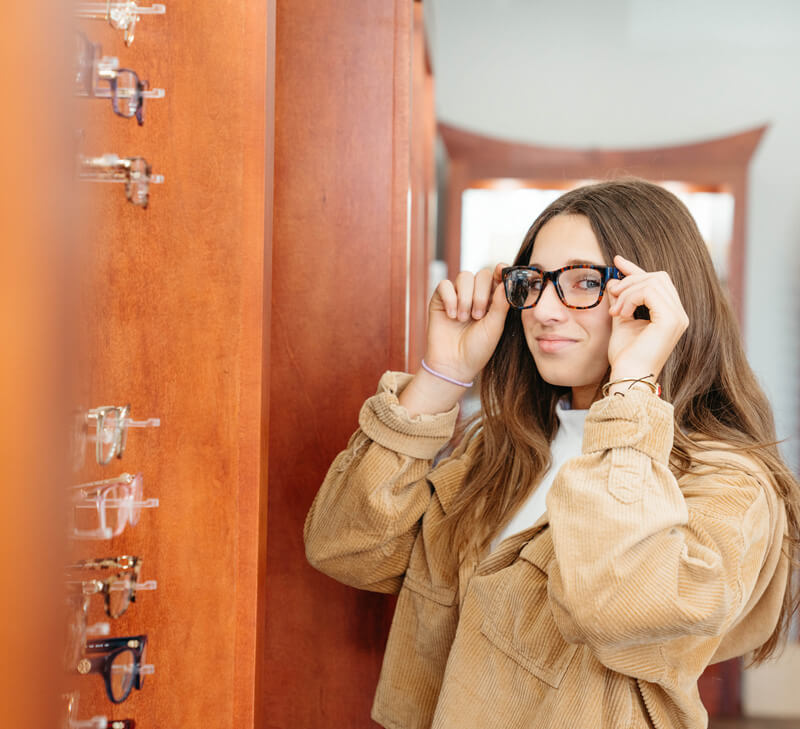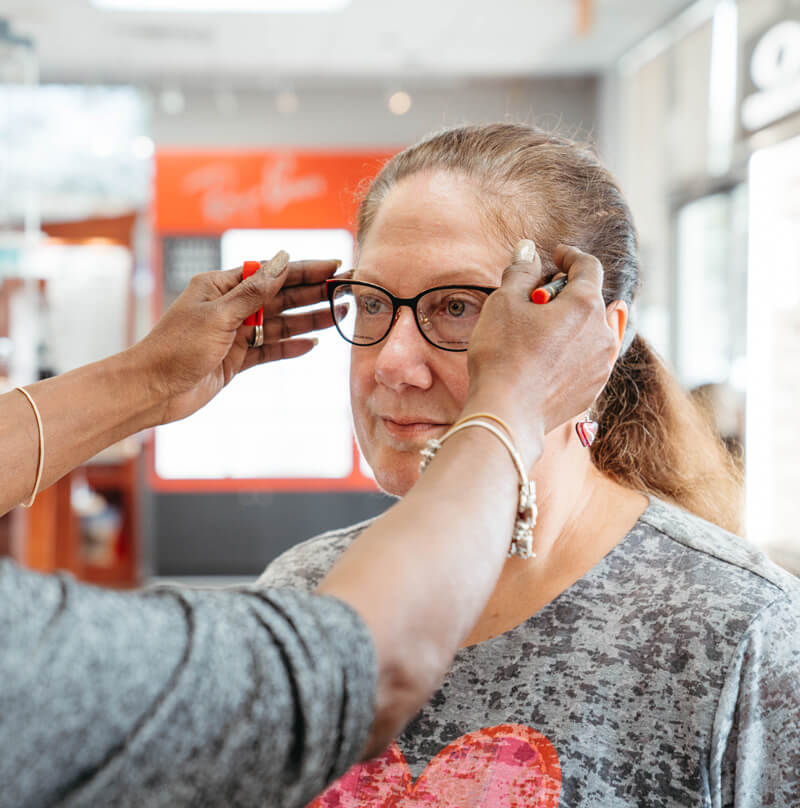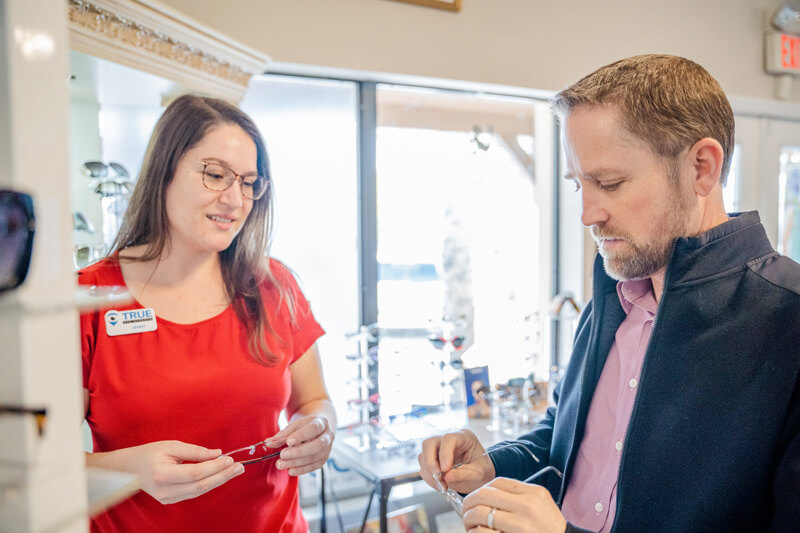Eyeglasses

Choosing Your Eyeglasses
Prescription lenses are the heart of what makes a pair of glasses provide the sharp, clear vision your eye doctor wants you to have. A fancy frame that is comfortable is a wonderful thing, but without quality lenses, they are useless. Modern technology is constantly advancing amazing new lens features and abilities, so that eyeglass wearers can customize their glasses to deliver vision, protection, and comfort in all aspects of their life.
The eye care industry has so many different innovators and advancements that it can be challenging to keep up with what is available. It is also difficult to determine what kind of lens is right for you.
At True Eye Experts, our team of opticians is highly educated, experienced, and trained on all modern lens applications. They are here to help design the perfect pair of glasses.

Prescription Design
We compartmentalize the makeup of a prescription lens into four different categories which contain different lens choices for our patients to make. True Eye Experts can provide expert advice on what type of eyeglasses will work best for you. The prescription design addresses your visual needs, whether you are nearsighted, farsighted, or need multiple prescriptions in one lens.
Single Vision: Single vision lenses provide clear vision for a specific distance, reading, or computer use. It is the most common type of lens and usually people’s first pair of prescription glasses.
Bifocal or Trifocal: This is an antiquated lens design that has a visible line that divides two (or three) different prescriptions in the lens. Typically, the wearer would look over the top of the lens to see far away and look below the line to read or see close up. Bifocals are typically prescribed for patients with presbyopia.
Progressive Lenses: The simplest way to describe a progressive lens is a lens that provides a vision for near, far, and everything in between. As more and more people graduate into progressive lenses, they have access to more technological innovations. The ultimate goal for every lens manufacturer is to replicate the ability to see both far and near with as little awareness of the glasses as possible.
However, not all progressive lenses are created equal. Older lens designs often have limited peripheral vision and lack a smooth progression from one prescription to the next. Modern progressives are designed from the ground up, taking a patient’s prescription, frame, face, and even posture into consideration to provide the best possible visual experience.
Our opticians can make an assessment based on your visual and lifestyle needs to help you choose your prescription design.
Lens Material
These three lens materials are some of the most common materials we use for our patients’ prescription glasses and all have different benefits depending on your interests and hobbies. See which materials might fit best into your lifestyle.
CR-39 (Optical Plastic): This lens material is one of the most available and easily mass-produced materials in the United States. Plastic generally provides a very clear image for the patient, but it also tends to be on the thicker and heavier side when compared to most other materials. It is also not rated to be impact-resistant, which makes it a poor choice for children, the elderly, or anyone that is a fall risk. It also is not recommended for anyone that drives frequently, as it may pose a threat in the event of an airbag deployment.
Polycarbonate: This is the most common lens material that we dispense at our office. Polycarbonate is an affordable thermoplastic and is rated for impact resistance. In addition to being very safe, it is also rather thin and lightweight in most prescriptions.
High Index Plastic: This is a polymerized material that is generally reserved for patients with high prescriptions or for patients that desire the thinnest lens possible in their glasses. High index is not a safety-rated material, but in some configurations, it can pass industry tests for impact resistance.
There are many other materials that exist that blur the lines between CR-39, polycarbonate, and high index plastic. Our office has access to any lens material on the market, and our opticians can help answer any questions or make recommendations for which material is right for you.


Anti-Glare or Anti-Reflective Treatments
The inherent downside to putting a lens that bends light directly in front of your eye is that it creates a glowing disc of glare and reflections. It is imperative that prescription lenses have a surface treatment to eliminate the glare caused by the lens itself to provide a crystal-clear portal to look through.
Non-Glare Coatings: This is the most affordable type of anti-reflective treatment. The non-glare treatment is sprayed onto the lens in a liquid form and cured under UV light until hardened. It is the easiest to produce in mass quantity and is the most affordable coating. The tradeoff is that it is also the most susceptible to scratching and deterioration over the life of the glasses.
Scratch Resistance: There is nothing more annoying for an eyeglass wearer than to have a scratch on their lens. It creates a distraction and unclear vision depending on the severity of the scratch. While there is no such thing as a scratch-proof lens, many lens surface treatments come very close. Current surface treatments include quartz that is ionically bonded to the surface of the lens, making it almost as scratch resistant as window glass.
Blue Light Protection: All non-glare treatments can have pigments added to them that protect and filter high energy visible (HEV) blue light. This wavelength of light is produced by electronic devices such as cell phones, tablets, and computers. HEV light is associated with digital eye strain and is linked to an increased risk for macular degeneration.
Water and Oil Repellent: Specialized treatments are available to act as a barrier to water and oil. This is extremely convenient to have on glasses because it makes them very easy to keep clean. These types of lens treatments are ideal for children or for people who work in messy environments such as kitchens.
Opti-Fog: This patented lens treatment is designed to resist water condensation and fog that occur when lenses transition from cold, dry environments to hot, humid ones. We have found that this lens works particularly well for people who wear helmets and have issues with their lenses fogging up from their own breath.
Lens coatings are a great way to customize your glasses and ensure a high-quality lens that provides clear vision.
True Eye Experts Prescription Glasses
It is a great time to be an eyeglass wearer. Our expert team of opticians is here for you to help in the process of selecting the perfect lenses for your prescription glasses. We strive to give you the utmost quality in vision and want your glasses to serve you in all aspects of your life. Call or stop by one of our offices for a free eyewear consultation and learn what you’ve been missing.
